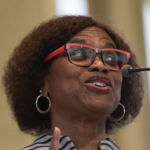
We compared the CDC’s earlier guidelines advising gatherings to the governor’s instructions limiting places of worship occupancy to 40%. Baker, no doubt, was under pressure not to be “too prescriptive.”
In the current phase of Massachusetts Governor Charlie Baker’s coronavirus reopening plan, all places of worship are now allowed to conduct services. However, questions remain about the prudence and safety of reopening them during an ongoing pandemic in which officials have not met testing targets.
Navigating guidelines and restrictions on religious institutions has been like stepping on and around landmines for Baker. Since the beginning of the state’s stay-at-home advisory in March, most churches have complied, but not all. In early May, more than 260 ministers from across the Commonwealth expressed their grievances in a signed letter to Baker, demanding their places of worship reopen with social distancing protocols before Baker finally lifted the ban.
“I want to open churches in a responsible and safe way,” Baker said on WGBH’s Boston Public Radio on May 21. Reopening places of worship as “essentials businesses” didn’t seem to be at the top of the governor’s list; still, Baker said he “had pressure around constitutional issues and couldn’t ignore it.”
The question of what limits local and state officials can place on religious practices in the name of public safety is an important one. First, these limitations should be measured by the gravity of the crisis. Second, these limitations should be assessed if certain places of worship or denominations are being singled out for stricter treatment or discriminated against. Neither was apparently the case for the 260 ministers who signed a letter to Baker demanding their places of worship reopen and contesting infringement of freedom of religion and freedom of assembly.
With First Amendment freedoms, in my opinion, come responsibility. Currently, COVID-19 continues to pose an existential threat to public health and safety. Many of the churches that flouted social distancing guidelines became hot spots in their regions, increasing infection and death rates in states including Arkansas, California, and Kentucky.
While we don’t know all the ways the virus is spread, the primary mode of transmission is respiratory droplets caused by coughing or sneezing in close contact. The request for churches to suspend their usual in-person gatherings is not curtailing worship because other ways to worship can be employed, like virtual streaming. The request is a mitigation strategy to temporarily press a pause button on one form of religious expression—crowd size—that can be identified with COVID-19 transmission.
If you want more confusion in this delicate balance between church and state, and First Amendment rights and the right to protect public health, simply add Donald Trump to the mix. The President of the United States made it emphatically clear that if governors did not follow his recommendations allowing in-person religious services to resume, he would “override” them.
“Some governors have deemed liquor stores and abortion clinics as essential, but have left out churches and other houses of worship, it’s not right,” Trump said at a White House briefing. “So I’m correcting this injustice and calling houses of worship essential. I call upon governors to allow our churches and places of worship to open right now.”
The restrictions on places of worship suggested by the Centers for Disease Control and Prevention were put in place to avoid a resurgence, but Trump exploits the issue to benefit his campaign. Initially, the president objected to the original CDC reopening guidelines, claiming they were “too prescriptive,” and that they infringed on religious liberty. The subsequent document was watered-down, and had no specific reopening instructions for places of worship.
I was on an Interfaith Community Leadership Zoom call for Cambridge clergy to discuss Governor Baker’s mandatory safety standards and checklist for houses of worship. As we compared the CDC’s earlier guidelines advising gatherings of no more than 10 people to the governor’s instructions limiting places of worship occupancy to 40%, confusion abounded more than clarity about safety. Baker, no doubt, was under pressure not to be “too prescriptive.”
Nationally the current CDC guidelines steer clear of Trump’s ire and landmines, and state the following:
The information offered is non-binding public health guidance for consideration only; it is not meant to regulate or prescribe standards for interactions of faith communities in houses of worship. Any decision to modify specific religious rites, rituals, and services should be made by religious leaders.
It is undeniable that COVID-19 clusters have been linked to churches. In this pandemic, the ongoing challenge for places of worship will be how to reopen and to protect public health. In an already divided country, health precautions should not be weaponized as an infringement on religious liberty. Instead, they should be seen as “essential” for maintaining the well-being and sustainability of a worshiping body.
HELP DIGBOSTON WEATHER THIS STORM AND CONTINUE PROVIDING ARTICLES LIKE THIS ONE
Rev. Irene Monroe can be heard on the podcast and standing Boston Public Radio segment ALL REV’D UP on WGBH (89.7 FM). Monroe’s syndicated religion columns appear and the Boston voice for Detour’s African American Heritage Trail. She is a s a Visiting Researcher in the Religion and Conflict Transformation Program at Boston University School of Theology.

